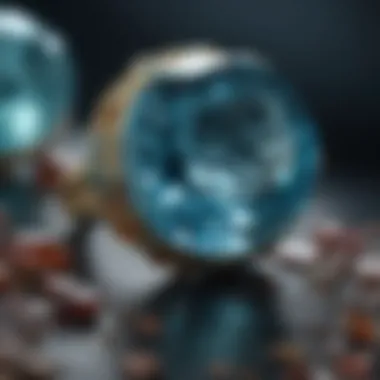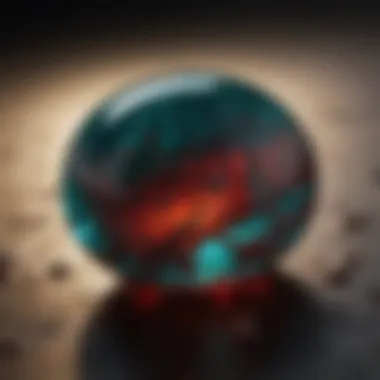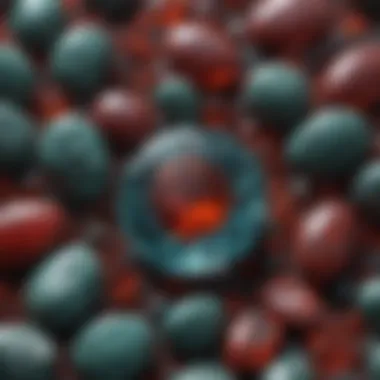Exploring March's Gemstones: Aquamarine and Bloodstone


Intro
March is not just a bridge between the chill of winter and the bloom of spring—it’s also home to two fascinating gemstones that embody the changing seasons. Aquamarine and Bloodstone offer more than just beauty; they carry rich histories and unique characters that contribute to their allure in jewelry and holistic health practices. This exploration will dive into their origins, properties, and uses, providing an enriching perspective for both seasoned collectors and novices alike.
Gemstone Overview
Aquamarine
Aquamarine, with its mesmerizing blue-green hues, resembles the tranquil ocean. This gemstone is a variety of beryl, primarily composed of aluminum, beryllium, and silicate. The name itself is derived from the Latin word aqua marina, which means "water of the sea." Its color can range from pale blue to deep blue, depending on the level of iron present during its formation.
Physically, aquamarine boasts a hardiness reflected in its Mohs hardness scale rating of 7.5 to 8, making it an excellent choice for daily wear in jewelry. This durability, paired with its stunning color, makes aquamarine a popular choice in rings, necklaces, and earrings. Also, it's typically found in countries like Brazil, Nigeria, and Madagascar, each location lending its unique flair to the stone's overall quality.
Bloodstone
In stark contrast to aquamarine, bloodstone, or heliotrope, is a dark green chalcedony flecked with bright red or brown spots, resembling drops of blood. Historically, it was believed to have potent magical properties—hence its name. Bloodstone is thought to have originated in ancient Mesopotamia, where it was used in seals, amulets, and carvings, serving as a protector against enemies and misfortune.
Physical characteristics of bloodstone include a Mohs hardness of 6.5 to 7, suitable for various types of jewelry, though it's less resistant to scratching than aquamarine. Much of the high-quality bloodstone comes from India, where legends continue to shape its cultural significance.
Healing Properties
Metaphysical Attributes
Both gemstones are revered for their metaphysical attributes that transcend mere aesthetics. Aquamarine is often associated with calmness and clarity—qualities that resonate with its tranquil color. Many believe it aids in clear communication and encourages emotional healing. Just like a serene sea, its energy helps alleviate stress and fears.
On the other hand, bloodstone is considered a grounding stone, thought to revitalize energy and increase resilience. Often linked to vitality, its red spots symbolize life force. Practitioners favor it for promoting courage and dispelling negative energy.
Common Uses in Holistic Practices
In holistic practices, aquamarine is commonly used in meditation, often worn as jewelry during sessions to promote tranquility and enhance focus. For those engaged in crystal healing, placing aquamarine at the throat chakra is said to boost self-expression and communication.
Bloodstone, conversely, is often carried as a talisman. Many individuals find it beneficial in situations demanding courage or when facing significant challenges. It is frequently used in rituals aimed at boosting confidence and shedding negativity, indicative of its historical roots in protective practices.
Bloodstone is not just about the rock; it’s a piece of history, a token of resilience.
Understanding these stones on a deeper level fosters greater appreciation, whether you’re wearing them, collecting them, or incorporating them into healing routines. As we continue this exploration, we will cover their historical significance, care recommendations, and how to harness their energies in everyday life.
Preamble to March Gemstones
March holds a special place in the world of gemstones, serving as a vibrant gateway to spring. This month’s notable stones, aquamarine and bloodstone, are not merely decorative; they bear historical and cultural significance that can enrich our understanding of birthstones and their meanings. Exploring these gems can reveal a lot about our connection to nature and our personal narratives.
The significance of birthstones extends beyond mere adornment. Many people feel a unique bond with their birthstone, often ascribing traits and properties to them that resonate with their individuality. Each stone is believed to carry certain energies and virtues, providing a sense of identity and purpose. The journey into the realm of March gemstones not only enhances our appreciation for their beauty but also allows us to tap into their potential benefits.
Significance of Birthstones
Birthstones like aquamarine and bloodstone are traditionally associated with various traits and attributes. For instance, aquamarine, often linked to tranquility and calmness, is thought to soothe the mind and body, making it a sought-after gem for those needing serenity in chaotic lives. Bloodstone, on the other hand, embodies courage and vitality. Its deep hues and robust presence inspire strength and resilience.
Many cultures throughout history have established beliefs around the powers of these stones. From providing protection to enhancing emotional healing, the significance of birthstones is woven into the fabric of many societies. Bringing these stones into our lives can be an invitation to connect with those deep-seated traditions.
Overview of March's Gemstones
Aquamarine
Aquamarine is often celebrated for its stunning clarity and serene blue-green tones that mirror the ocean's depths. This gem's origins are steeped in folklore, where it was reputed to be the treasure of mermaids, symbolizing good luck and protection for sailors. Its key characteristic lies in its exceptional clarity, making it a preferable choice for jewelry designers seeking to capture the beauty of the sea.
What makes aquamarine particularly appealing is not just its aesthetic allure but also its perceived soothing properties. Many gemstone enthusiasts appreciate the idea that this stone can enhance emotional healing, encouraging clear communication and reducing stress. While aquamarine's benefits are numerous, it is essential to consider that its delicate nature requires specific care to maintain its luster.


Bloodstone
Bloodstone, often referred to as the warrior's gem, is a unique stone characterized by its rich green surface highlighted with red spots, resembling drops of blood. Historically, it was used as a talisman for warriors, believed to provide them with courage in battle. Its striking appearance sets it apart and gives it an aura of mystique that attracts collectors.
The key feature of bloodstone lies in its historical association with life and sacrifice, appealing to those who admire stones with a story. It is heralded in various cultures for its ability to stimulate courage and confidence, making it a popular choice among those who seek to empower themselves. However, like many gemstones, proper maintenance is critical, as neglect can lead to the loss of its unique luster.
"Gemstones are not just pretty; they carry stories etched within their facets and colors."
In summary, March's gemstones include aquamarine and bloodstone, each exuding unique characteristics and benefits, crafting a narrative of its own. Delving into their history, spiritual significance, and potential applications can enhance one’s appreciation for the beauty they represent.
Aquamarine: The Stone of Serenity
Aquamarine, known as the stone of serenity, holds a place of prominence in the world of gemstones associated with March. This beautiful blue-green stone has captivated onlookers throughout the ages. Its calming colors are said to represent peace and tranquility. As we explore aquamarine, we will delve into its origins, unique properties, historical significance, healing benefits, uses in jewelry, and care requirements.
Origins and Formation
Aquamarine is a member of the beryl family, alongside emerald and morganite. This stone is primarily formed in granite and pegmatite, where it emerges through intense geological processes. These formations often occur in regions rich with minerals. Notably, Brazil is one of the leading producers of aquamarine, but you can also find deposits in Nigeria, Madagascar, and Zambia.
Properties of Aquamarine
Color and Clarity
The color of aquamarine can range from pale blue to deep sea-blue, often resembling a soft ocean wave. A standout feature of aquamarine is its exceptional clarity, which allows light to dance beautifully when the stone is cut properly. This clarity not only enhances its aesthetic appeal but also increases its desirability in the market. The more vibrant the color, the higher the quality and price of the stone, making aquamarine a favorable choice for many gemstone enthusiasts.
Hardness and Durability
Aquamarine ranks between 7.5 and 8 on the Mohs scale, indicating that it is fairly resistant to scratches and damage. This durability is a significant advantage, making it suitable for everyday wear, especially in rings and bracelets. Knowing it can stand the test of time without losing its charm adds to aquamarine's reputation as a reliable and popular choice in the jewelry market.
Cultural and Historical Significance
Legends and Myths
Throughout history, aquamarine has been surrounded by numerous legends and myths. It was believed that sailors carried aquamarine to ensure safe passage over turbulent waters. This tradition stems from the stone's calming properties, which were thought to provide protection against dangers at sea. Additionally, it was popularly regarded as the gem of mermaids, adding to its allure.
Usage in Ancient Civilizations
In ancient civilizations, aquamarine was held in high esteem. Romans were known to dedicate it to Neptune, the god of the sea, while Egyptian priests often used the stone in amulets for protection and healing. Its historical significance lends a sense of depth to aquamarine, making it more than just a gemstone.
Healing Benefits of Aquamarine
Emotional Healing
Aquamarine is celebrated for its emotional healing benefits. It is said to clear away emotional baggage and promote a sense of calm, making it a popular choice for those seeking balance in their lives. Many believe that meditating with this stone can enhance clarity of thought and improve communication skills, helping to foster healthier relationships.
Physical Benefits
When it comes to physical healing, aquamarine is often associated with soothing ailments related to the throat and respiratory system. Some practitioners of holistic healing recommend wearing this stone during meditation or therapy, as it is thought to assist in physical recovery and bolster the immune system.
Jewelry Applications
Design Trends
Aquamarine has found its way into the heart of modern design with trendy styles emerging every season. Whether set in simple gold bands or ornate silver necklaces, architects of fashion find this gemstone versatile and striking. The trend of layering aquamarine pieces has gained traction, adding an elegant yet casual atmosphere to everyday ensembles.
Styling Tips
When styling aquamarine in jewelry, consider its serene tones that pair well with both warm and cool colors. Its soft blue hue complements a variety of outfits, making it a go-to choice for various occasions. For those wanting to make a statement while keeping it classy, incorporating aquamarine earrings with a monochrome outfit can elevate the overall look effortlessly.


Care and Maintenance
Cleaning Techniques
To maintain the beauty of aquamarine, gentle cleaning techniques are advisable. A mild soap solution with warm water is often recommended for removing dirt and grime. Avoid using harsh chemicals or ultrasonic cleaners, as these may damage the stone's structure.
Storage Recommendations
For safe storage, it’s best to keep aquamarine jewelry separated in a soft pouch or lined box to prevent scratching. This small step can help preserve its luster and extend its life significantly.
"Aquamarine is not just a beautiful stone; it’s a symbol of soothing energy and tranquility, resonating powerfully with those who seek peace within."
Bloodstone: The Warrior's Gem
Bloodstone, often referred to as the warrior's gem, carries a deep significance that resonates with strength and resilience. This gemstone is steeped in historical importance, often associated with courage, vitality, and the ability to withstand adversities. Its unique qualities, particularly its striking appearance and multifaceted properties, make it a fascinating subject in the exploration of March's gemstones.
Origins and Properties
Bloodstone is made of chalcedony, a form of quartz, giving it a lovely solidity. This gemstone stems from volcanic activity and is primarily found in places like Brazil, India, and Australia. Its origins reveal a story of natural wonder and geological transformation. The stone’s unique composition, featuring iron oxides, lends to its earthy tones and marbled patterns.
Characteristics of Bloodstone
Color Variations
Bloodstone is famous for its rich hues, which often include deep greens and vivid reds. This color interplay results from the presence of iron, which gives the stone its characteristic mottled look. One of the appealing aspects of bloodstone’s color variations is how they can suit different personal styles and preferences. The rich, dark green backdrop, accented by flecks of red, becomes a conversation starter in any jewelry piece it adorns, showcasing both strength and beauty.
However, it’s worth acknowledging that these color variations also present an interesting narrative in jewelry design. Different shades of bloodstone can influence the overall aesthetic, presenting an advantage in personal expression but also challenging the designer in creating harmonious combinations.
Structure and Composition
The structure of bloodstone is noteworthy, too. Its microcrystalline structure makes it durable yet relatively easy to work into various jewelry forms. This combination of hardness and workability makes it popular among designers but requires some knowledge of its limitations. For example, while it can resist scratches to a point, it’s not invulnerable to impacts, which means care is necessary to maintain its pristine condition.
In sum, the interplay of structure and composition provides a valuable insight into how bloodstone can be utilized in a variety of settings, marrying utility with aesthetics seamlessly.
Historical Context and Usage
Symbolism in Various Cultures
Throughout history, bloodstone has carried considerable symbolic weight. It has been seen as a talisman of protection and courage, often associated with warriors who believed it could help them in battle. The belief in the stone's power varies across cultures; in ancient Rome, for instance, it was thought to bring good luck to gladiators. This historic echo of strength can still be felt today, as many continue to gravitate towards its protective connotations.
Moreover, the cultural perceptions of bloodstone show how valuable it has been across different epochs and societies. Different societal views around this gem illustrate its versatility, serving not only as a part of adornment but also as a bridge to the metaphysical health of its bearers.
Notable Historical Artifacts
There are several notable historical artifacts that have been crafted from bloodstone, displaying its importance through the epochs. One famous example is the helmet of Alexander the Great, which is believed to have been inlaid with bloodstone. These artifacts not only demonstrate the craftsmanship of past centuries but also highlight the belief in the stone's magical properties.
The recognition of bloodstone in significant historical contexts enhances its allure today, making it not just a decorative piece, but a connection to something far larger than ourselves.
Healing Properties of Bloodstone
Physical and Emotional Benefits
Many practitioners in holistic healing praise bloodstone for its supposed ability to enhance energy and physical vitality. Some say that it can stimulate the blood, promoting circulation and cleansing. On the emotional front, bloodstone is often believed to help in decision-making, promoting necessary courage. This dual benefit of physical and emotional support positions bloodstone squarely within the realm of wellness and self-improvement.
Uses in Healing Practices
Bloodstone is widely used in various healing practices. From crystal therapy to meditation, this gemstone serves as a tool to ground oneself amid the chaos of modern life. Its capacity to center and stabilize makes it a popular choice among practitioners of alternative health.


As the wellness movement continues to flourish, bloodstone’s unique attributes will likely see it grow in popularity among both newcomers and seasoned practitioners.
Incorporating Bloodstone in Jewelry
Current Fashion Trends
In today’s jewelry scene, bloodstone is making waves once more, largely due to its rich heritage and versatile aesthetic. Jewelry designers appreciate its ability to pair well with both traditional and modern designs. Current trends indicate a resurgence of earthy tones in fashion, making this gemstone a prime candidate for both statement pieces and subtle accessories alike.
Mixing with Other Gemstones
Bloodstone’s ability to mix well with other gemstones adds another layer of appeal. When combined with complementary stones like lapis lazuli or turquoise, designers can create dynamic and visually striking pieces. This flexibility in blending makes bloodstone an essential ingredient for any jeweler looking to push the aesthetic envelopes.
Maintenance Tips
Cleaning Recommendations
To maintain bloodstone’s natural beauty, careful cleaning is essential. A simple solution of mild soap and water can be used to scrub the surface gently. It’s advisable to avoid harsh chemicals and ultrasonic cleaners, ensuring that the stone retains its integrity over time. Proper cleaning put forth a beneficial practice that enhances its longevity while preventing dullness.
Preserving Luster
To keep bloodstone sparkling, store it away from harder stones or objects that can scratch its surface. A soft cloth pouch is preferred to avoid the wear and tear of daily use. Proper storage not only prolongs the stone’s luster but also preserves the stories embedded within, making it ready to shine in present and future styles.
"Every gemstone tells a story, and bloodstone’s narratives span ages, cultures, and crafts, weaving together our human experiences with beauty and resilience."
Through the lens of fashion, history, and healing, bloodstone remains an indefatigable symbol of strength and elegance. Its resilience embodies the enduring human spirit, drawing enthusiasts and collectors alike into its captivating realm.
Comparative Analysis of March Gemstones
Understanding the differences and similarities between the two primary gemstones of March—aquamarine and bloodstone—provides valuable insights into their distinctive characteristics. This comparative analysis is not merely an academic exercise; it enhances appreciation for these stones and highlights their unique properties and significance. By dissecting their visual differences, cultural perceptions, and healing applications, gemstone enthusiasts and collectors can gain a better grasp of what makes each stone special. This knowledge is instrumental for jewelry designers seeking to incorporate these stones into their creations, providing context and purpose behind their aesthetic choices.
Visual Differences
At first glance, aquamarine and bloodstone appear quite different, almost like night and day. Aquamarine is celebrated for its tranquil hues, often embodying shades of blue and green reminiscent of calm waters. Its clarity and luster can be stunning, almost inviting one to plunge into its depths. The typical aquamarine gem is transparent, allowing light to dance within, creating a serene glow that whispers of tranquility.
On the contrary, bloodstone, also known as heliotrope, showcases an earthy palette. Its rich green surface is often sprinkled with deep red spots that resemble blood—hence the name. This unique color contrast signifies strength and resilience, making bloodstone a captivating choice for those who appreciate bold, striking visuals. While aquamarine's beauty lies in its subtlety, bloodstone is unapologetically expressive, often drawing people's attention with its vivid pattern.
"To behold these two March gemstones side by side is to appreciate nature's artistic diversity; each holds its own story, begging to be told."
Cultural Perceptions
The cultural significance of both aquamarine and bloodstone has evolved over centuries and across civilizations. Aquamarine, historically tied to the sea, has been venerated by sailors who believed it protected them from the perils of the ocean. Ancient Romans viewed this gemstone as a token of happiness, and it was often used in charms to bring good fortune. The modern perception aligns with this heritage, where aquamarine is seen as a symbol of peace and serenity, often associated with calmness and tranquility in today’s hectic world.
Bloodstone, however, tells a different narrative. This stone has long been associated with courage and sacrifice. In various cultures, it was believed to possess healing properties, particularly for the physical body and spirit. In the Middle Ages, bloodstone was revered as a powerful talisman, said to invoke strength in battle. Even today, many people regard bloodstone as essential for grounding energies and boosting one's stamina.
Healing Applications
Both aquamarine and bloodstone carry a wealth of healing benefits, appealing to those interested in holistic practices. Aquamarine is often linked to emotional healing, helping to soothe anxiety and promote peaceful communication. Many believe it can alleviate stress and boost clarity of thought, making it an excellent choice for those navigating challenging situations in life. Its calming effect is thought to balance emotions, aiding individuals in embracing their authentic selves.
Bloodstone, conversely, portrays a more robust healing narrative. It's believed to bolster physical well-being, enhancing energy levels and promoting detoxification. Those who seek to harness bloodstone in their healing practices often report an increase in vitality, making it a favored choice among athletes and those engaged in physically demanding activities. Additionally, it is thought to rejuvenate the spirit, helping to dispel feelings of anger and confusion.
In summary, the comparative analysis of aquamarine and bloodstone showcases not just their visible distinctions but also the cultural narratives and healing applications that shape the ways these gemstones are perceived and valued. For gemstone enthusiasts, understanding these elements deepens their connection to these stones and enriches their appreciation, making each stone not just a pretty object but a meaningful part of human history and experience.
Ending
As we wrap up this investigation into the gemstones of March, it’s clear that these stones, aquamarine and bloodstone, are far more than mere adornments. They carry deep historical significance, represent cultural narratives, and offer a wealth of healing benefits. The importance of understanding these gemstones extends to not just appreciating their beauty but also recognizing their versatility in jewelry design and holistic practices.
Final Thoughts on March Gemstones
In learning about aquamarine and bloodstone, we uncover a tapestry of stories interwoven through civilizations. Aquamarine, often thought of as a symbol of tranquility, has historically found its place in maritime lore, believed to calm the seas and protect sailors. On the flip side, bloodstone evokes images of strength and resilience, harking back to ancient warriors who donned it as a talisman in battle. The vast properties and meanings attributed to these stones open doors to a richer appreciation, enhancing both personal connections and broader insights into our shared human history.
Encouragement for Further Exploration
It’s important to keep the curiosity alive. Exploring gemstones, be it through collecting, studying, or jewelry design, not only enriches personal knowledge but also fosters a connection to the Earth’s treasures. Engaging in communities, whether on platforms like Reddit or Facebook, can spark discussions and ideas on how to incorporate these gems into daily life or art. Additionally, visiting museums or gem fairs can enhance understanding of gemstone origins and the artistry behind each piece. Embrace the journey of learning, and let the stories of these stones inspire and inform a deeper connection with the world of gemstones.







